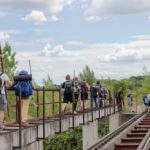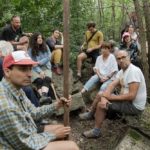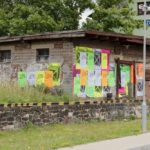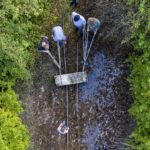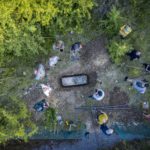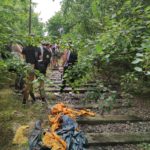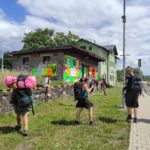Prague-Zličín railway station
The station building dates back to 1878. Today, it no longer serves its original purpose, but inside it preserves evidence of its own history – the original ticket office and staircase; the outer covered platform with preserved wooden elements is also original. On the first floor, there are visible structural modifications from the time when the premises were used for private housing. The building is currently awaiting renovation and the discovery of a new meaningful content.
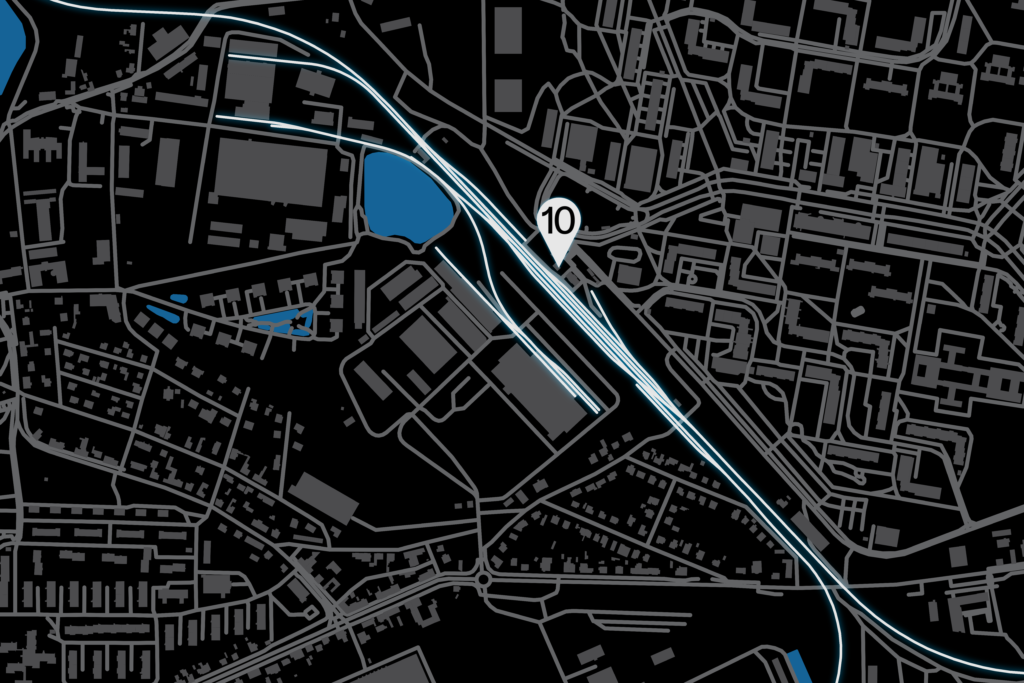
Epos 257
Albert Šturma, Martin Netočný
A piece of quasi-research into what this neighbourhood is not and what it does not mean.
Our temporary research station has strict rules and is about to abuse the public for research purposes. We’re going to be making obsessive-observational forays into the wider surroundings. We are a research group that will continuously invite other related explorers to research.
(a) A non-rigorous analysis of the status quo: The spectacle-free site, full of impenetrable scrub, bindweed and reed grass, lies fallow, on the lookout for the revival processes that will finally liberate its dormant capital potential. The industrial era is over, and so is the nearby wagon factory. The area of thousands of square metres has been parcelled out for several years now with names like residential area and munificent private park. Meanwhile, as the uncultivated vegetation proliferates rampantly and weaves its way through the world of real-estate development plans, one residential unit after another of the planned five hundred and twenty-six is being sold. Singles, young couples, and families with children will all find what they want. And even if there are just speculators in the end, the line between chaos and order will be set once and for all. Where purpose is hidden today, it will emerge more clearly than we could ever have imagined. Already, ideologically, the concrete accommodation blossom is blooming with a temporary veneer of luxury, with superb 24/7 shopping and fitness. For generations to come!
(b) A manifesto instead of an introduction to the topic: We will have no reason to ask: “What is the name of this place?” We will take it as a given, wrapped in leisure and active relaxation, civic amenities and transport accessibility. Like a greasy doughnut, ready to be eaten. Today, however, we can still put such questions, under the bark of trees, for example. We have the last few months, maybe years, to do so. Then the area beyond the boundary of the nearby housing estate will be transformed from a question mark into a striking statement. A clear structure enters, not unlike the one we would find when following a vector towards the city centre. To centralise is to articulate and therefore to instil purpose. We are not interested in purpose. We are interested in its boundary with what collective rationality cannot encompass.
We are ![]() !
!
(c) Methodology not strictly and correctly followed: We wrap ourselves in a locality devoid of spectacle. In the bosom of nature, we trap our limbs in the snares of bindweed and scrub. We oscillate among the reed grass, which vibrates in the wind. We place into the landscape random assumptions about where the city ends and begins before the aesthetics of the digital render tell us. We light dirty fires in places where construction mixers will soon start to rattle and metal struts will be forever covered in concrete. Last but not least, we also index, archive, and document our research lability for future times when the site is given a name and segmented by streets and small patches of unbuilt terrain that will also be distinctly named.
We have to fix it!
We are ![]() !
!
Epos 257, Jan Albert Šturma, Martin Netočný
Implementation team
Artistic director:
Čestmír Suška
Curators:
Dagmar Šubrtová and Iva Mladičová
Manager of production:
Ivana Vodičková
PR:
Klára Sofie Střihavková
Production:
Dan Toman, Josefína Frýbová,
Jarka Janíčková
Technical manager:
Martin Pertl
Grafic design:
Jáchym Moravec and David Babka
Web:
Simona Sušková
Special thanks to:
Miroslav Bílek, Blanka Němcová, Vojtěch Pollák, Richard Janeček, Matěj Remeš, Rebeka Široká, Matyáš Kořínek, Vladislav Tesárek – Kladenský pivovar
Patronage
The patronage of the m3 Festival was kindly accepted by:
Mgr. Milan Volf
Mayor of Kladno
Doc. Ing. arch. Petr Hlaváček
Deputy head of the city of Prague
MgA. Hana Třeštíková
Councilor of the city of Prague
Czech Chamber of Architects
MgA. David Kašpar
Deputy Mayor of District P10
Mgr. Ondřej Kolář
Mayor of District P6
For schools
- Grafické listy
